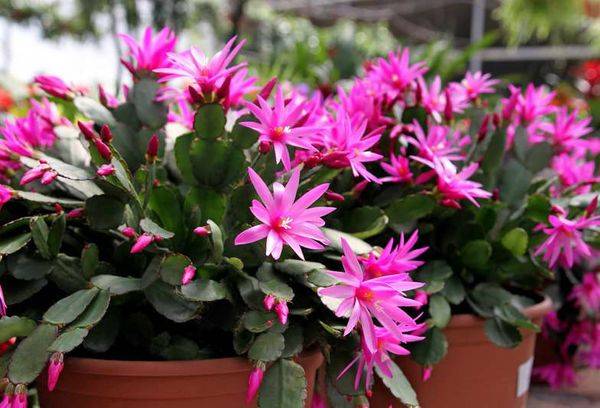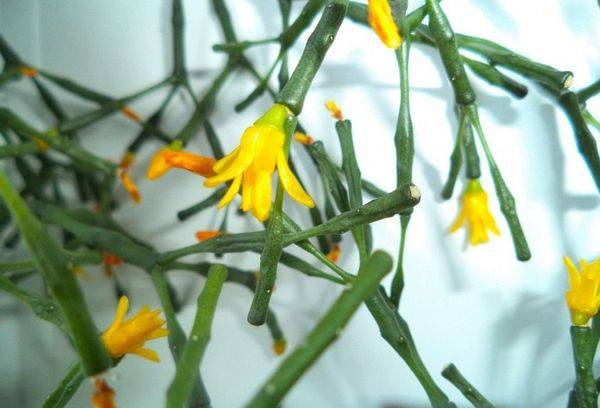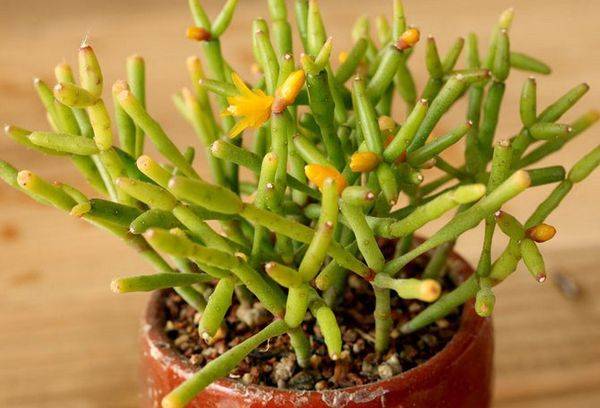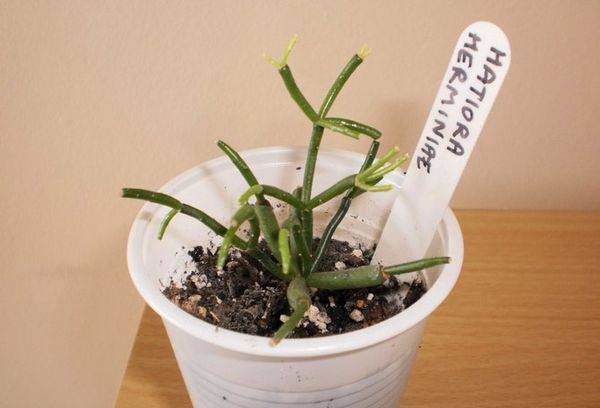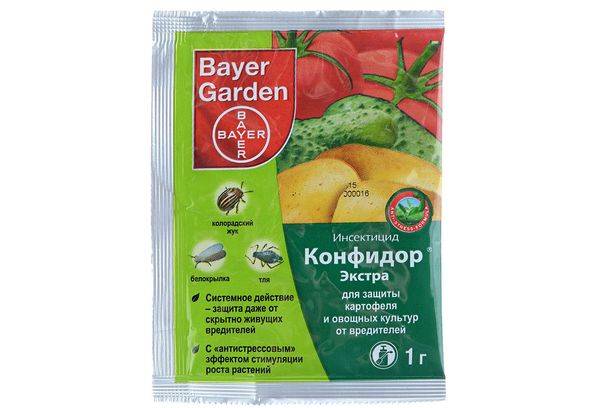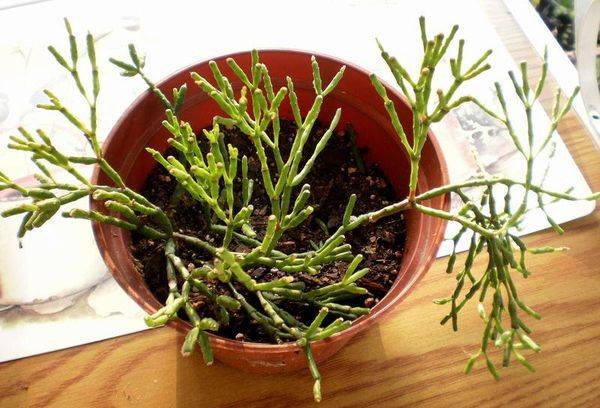How to care for a hatiora at home
Content:
A plant that cannot be confused with any other, thanks to its bizarre appearance, is hatiora. Caring for it at home is absolutely not difficult, and the plant blooms profusely in the winter months.
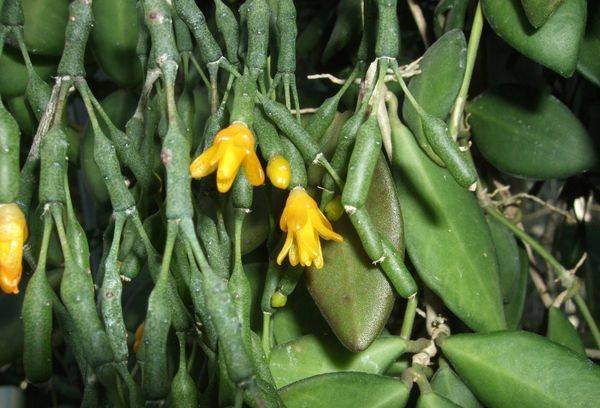
Hathiora Grazer
Description
Hatiora, or as it is sometimes popularly called, the dancing skeleton, belongs to the cactus family and, accordingly, is a succulent. The plant has unusual segmented stems that grow in all directions, for which it received a playful nickname. Under natural conditions it can reach two meters in height. Hatiora was first seen in the tropical climate of Brazil and is therefore considered exotic.
Common habitats are rock crevices and trees. Hatiora shoots stretch vertically upward, but droop over time. At three to four years of age, the plant becomes very similar to a small tree, as the trunk gradually becomes woody.
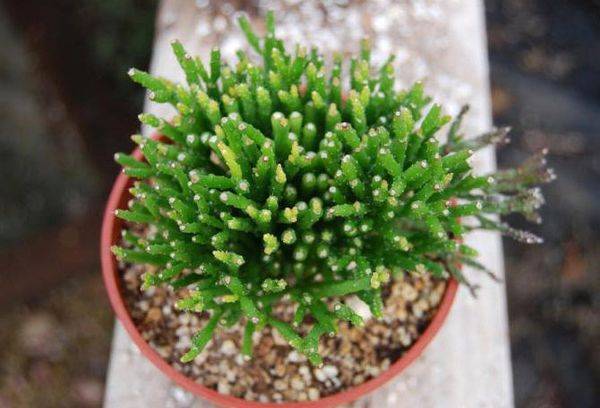
Hathiora salicorniformes
Hatiora salicornioides blooms very beautifully - bright yellow flowers appear, but in order to see them, it is necessary to create optimal conditions for the plant.
Varieties
Six varieties are most suitable for growing at home:
- Hatiora rosea has flat, elliptical stems, bright green, with a reddish tint; during the flowering period, large pale pink flowers are formed.
- Hathiora five-winged is a plant with ribbed stems, similar to a small bush, the flowers are small and white.
- Hathiora Gertnera - the stems are flat, have an elongated ellipse shape. It is distinguished by large segments, up to 7 cm in length. Budding usually occurs in spring with red funnel-shaped flowers.
- Hatiora Graesera is a hybrid and was obtained by crossing Gertner with Rosea. The flowers are usually red-burgundy, but sometimes other shades are found. The shape of the segments is elongated, elliptical.
- Hathiora salicornia is characterized by unusually branched stems, resembling bottles and consisting of many small segments. In general appearance, the plant resembles a low (40 cm) lush tree. The flowers are shaped like bells and can be pink, yellow, or red.
- Hathiora salina also branches strongly, due to which it forms voluminous bushes. The stems consist of small segments, the length of which does not exceed 2.5 cm. The flowers are also medium-sized, salmon or yellow-orange in color.
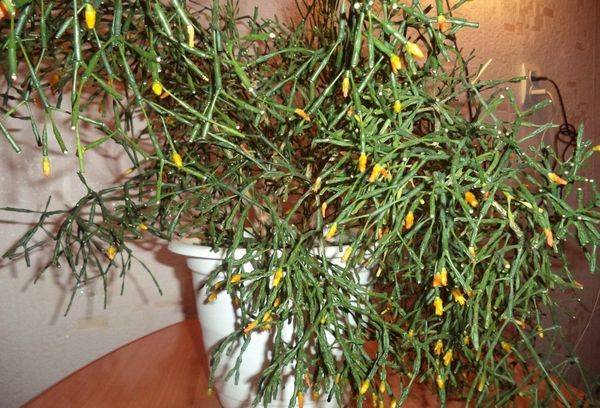
Hathiora saltwort
Home care: light and warmth
Popular varieties of hatiora grow and reproduce well in indoor conditions due to their undemanding nature.
Lighting. Hatiora can develop in a shaded and well-lit room, but still the best option would be the windowsill of a western or eastern window. A plant placed on the south side will need to be protected from direct rays of the sun (their exposure can lead to burns).The hatiora located on the northern windowsill will need to be illuminated with a phytolamp. If the lighting is inappropriate, flower growth will slow down and the flowers will be small and sparse.
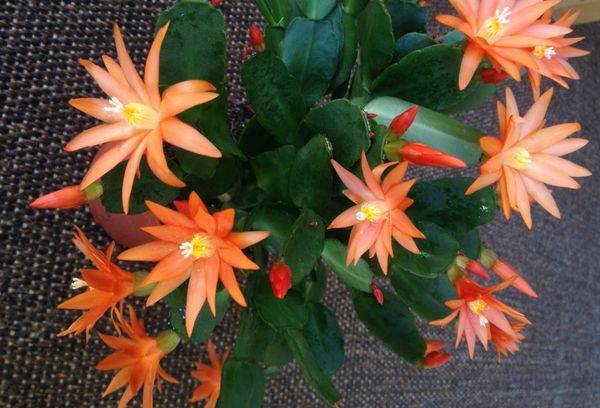
Hatiora Gertner
Temperature regime. Normal room temperature in the range from +18 to +23˚ C will be quite suitable for hatiora. To set buds in the fall, the flower requires special care. Create conditions for a period of rest: lower the temperature in the room. For a maximum of two months, the thermometer should not be below +10˚ C or above +17. In the summer months, the plant can be taken out into the fresh air, but shading from the hot rays of the sun must be provided.
Advice
Hang the hatiora pot on one of the lower branches of the tree: the plant will be very comfortable under the crown.
Hydration
Artmosphere. For the hatiora, dry air is part of its natural habitat, so it tolerates insufficient humidity well. On particularly hot days, additional foliar watering will be required. In hot weather, spray the flower with a spray bottle, place wet pebbles or expanded clay in the tray of the pot, a fountain next to the plant would be a good idea.
Watering. During the warm months of the year, hatiore needs abundant watering. It is a succulent, which means it stores water in its stems. Lack of moisture in the soil manifests itself in wrinkling and shriveling of the shoots, but once the flower is watered, it returns to excellent shape. Prolonged drought will cause segments to drop.
The plant should be watered when the top layer of soil mixture in the flowerpot dries thoroughly. Soft, well-settled (at least 12 hours), lukewarm water is ideal for the procedure. 30-40 minutes after watering, drain excess liquid from the pan.
Excess moisture in the soil can cause rotting of the root system. In winter, the plant needs moderate watering, and in the fall, during the dormant period, it is stopped altogether.
Soil and fertilizers
Priming. A ready-made mixture intended for growing cacti and succulents, which is widely available in flower shops, is ideal for hatiora. To make a suitable substrate with your own hands, you will need to take turf and leaf soil, humus and sand in equal proportions. It is important that the soil is loose and has good air permeability; be sure to lay a layer of drainage at the bottom of the pot.
Advice
The magazine purity-en.htgetrid.com recommends adding a little peat or brick chips to make the soil mixture looser.
The soil must have a slightly acidic or neutral reaction.
Feeding. Mineral fertilizers should be applied twice a month, simultaneously with watering, during flowering and active growing season. The calcium and nitrogen content in the solution should be minimal (nitrogen causes rotting of the root system of cacti). Select fertilizers for feeding that contain nutrients in the following proportion: 24 parts potassium, 18 parts phosphorus and 9 parts nitrogen.
Reproduction and transplantation
Hatiora is propagated by cuttings: unscrew a fragment consisting of 2-3 segments, sprinkle the resulting wound with crushed coal. Place the cuttings for 3-5 days to dry, and then plant them in damp sand or substrate. The cuttings should be watered exclusively through a tray and only after the soil is completely dry. With proper care next year, a flowering bush will form from the cuttings.
Sometimes segments torn from the plant fall onto the soil mixture and germinate without outside help. Reproduction of hatiora will not cause difficulties even for novice gardeners.
The plant should be replanted in the spring after flowering has ended. In this case, special attention is paid to the size of the pot: it should be low, the root system should be left 1 cm of free space for growth. Young hatiors need to be replanted every year, adults - once every 2-3 years. Very large specimens can be relocated even less frequently - once every 4-5 years.
Pests and diseases
The most dangerous for hatiora are whitefly, spider mites, scale insects and mealybugs:
- the invasion of the latter is indicated by white spots on the segments;
- yellow dots on the stems indicate spider mite infestation;
- a sickly appearance and yellowing of the plant indicate the appearance of scale insects and whiteflies.
If their numbers are small, you can get rid of pests by collecting insects by hand, taking a hot shower (water temperature should be no more than 40˚ C) and spraying with a solution of laundry soap.
In case of severe damage, the hatiora should be treated with an insecticide in accordance with the instructions for use several times. The interval between spraying should be 7-8 days. “Aktara”, “Aktellik”, “Confidor” are suitable.
Among the diseases, hatiora most often suffers from bacterial infection, late blight and fusarium.
A bacterial infection manifests itself as slippery, wet spots on the shoots. To get rid of the scourge, remove the infected segments and treat the plant with an antibacterial agent. Unfortunately, treatments do not always give the desired result.To save a flower, tear off a healthy segment and grow a new hatiora from it, and throw away the diseased plant so that the infection does not spread to the seedling.
Late blight and fusarium affect the root collar. The shoots become pale and wither, regardless of the degree of moisture in the substrate. Treatment is with fungicides.
Useful tips
A few recommendations from experienced gardeners for caring for hatiora:
- The plant does not bloom if there are insufficient nutrients in the substrate or if there is no dormant period with low air temperatures and minimal watering.
- Segments begin to wither and shrink when there is very dry hot air in the room and insufficient watering. Spraying and moistening the soil mixture will save the situation.
- Segments may fall off and buds may fall off if the roots are rotten, the air temperature in the room is too low, pests have settled on the plant, or it is sick.
Signs and superstitions
Some believe that a hatiora that appears in a house brings discord and scandals to the family; they often blame the plant for women’s loneliness and the departure of their husbands. There is no scientific data that would confirm such a superstition, so everyone decides for themselves whether to believe hypotheses about the negative impact of a flower on family happiness.
Like any other indoor plants, hatiora needs care, but the main secret to successful cultivation is moderation and maintaining a dormant period. For the amount of love and care shown, the flower will reward you with bright blooms and delightful curly branching.
